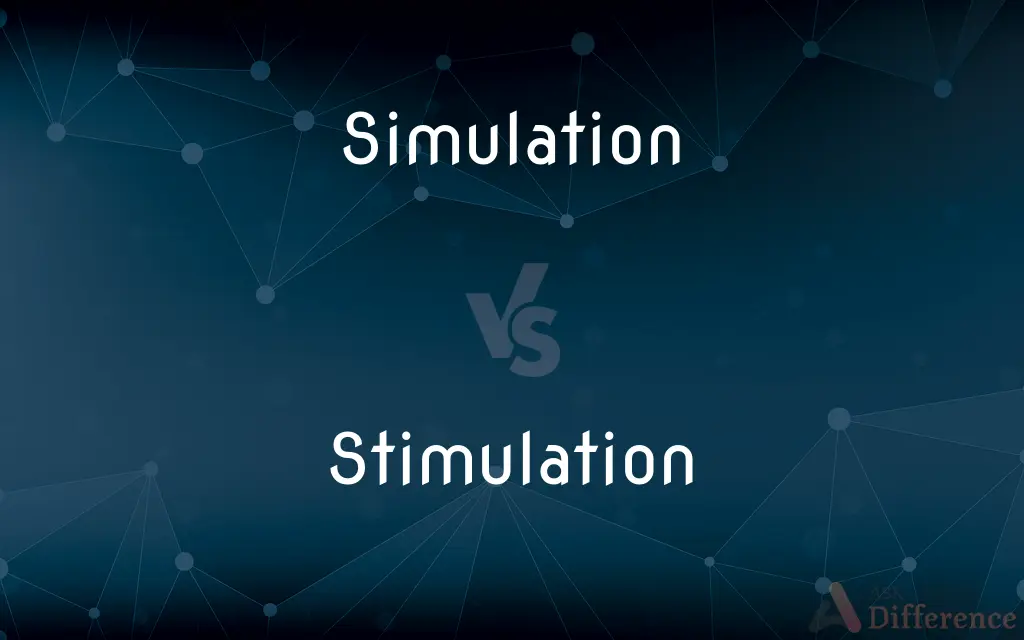Simulation vs. Stimulation — What's the Difference?
By Tayyaba Rehman & Maham Liaqat — Updated on March 8, 2024
Simulation replicates real-world processes or systems for analysis or training, while stimulation involves provoking or enhancing a response or activity.

Difference Between Simulation and Stimulation
Table of Contents
ADVERTISEMENT
Key Differences
Simulation involves creating a model or virtual representation of a real-world scenario, system, or process to study its behavior under various conditions without the risks or costs associated with real-world experimentation. In contrast, stimulation refers to the action of applying a stimulus to provoke or enhance an activity in a biological, physical, or chemical system, aiming to elicit or augment a response.
While simulation is widely used in fields such as aviation, medicine, and engineering to train professionals, analyze systems, and predict outcomes, stimulation is employed in areas like neuroscience, physical therapy, and education to enhance learning, rehabilitate injured muscles, or study brain activity.
Simulation tools and software allow for the detailed modeling of complex systems, enabling researchers and professionals to gain insights into the behavior of these systems in a controlled and safe virtual environment. On the other hand, stimulation techniques, such as electrical or magnetic stimulation, directly interact with biological tissues or systems to understand or influence their function.
The objective of simulation is often to predict, analyze, or understand the behavior of systems under various hypothetical conditions, thereby aiding in decision-making and training. Conversely, the goal of stimulation is to directly influence or investigate the functioning of a system, such as enhancing muscle activity or inducing brain responses, for therapeutic, research, or educational purposes.
Simulation creates an artificial environment for safe experimentation and learning, focusing on the replication and analysis of systems. Stimulation, however, involves the application of external factors to directly provoke or enhance the activity within a system, focusing on the immediate manipulation of its behavior or properties.
ADVERTISEMENT
Comparison Chart
Definition
Replicating real-world processes for analysis.
Provoking or enhancing a response.
Application
Training, system analysis, prediction.
Therapy, research, education.
Tools/Methods
Software models, virtual reality.
Electrical/magnetic fields, physical stimuli.
Focus
Understanding behavior in a virtual environment.
Directly influencing system's activity.
Outcome
Insight into system behavior, decision support.
Enhanced or induced activity within a system.
Compare with Definitions
Simulation
A virtual flight simulator.
Pilots train on flight simulators to experience flying without real-world risks.
Stimulation
Induces specific responses.
Stimulation in research helps understand cellular reactions.
Simulation
Predicts outcomes.
Financial simulations help predict market trends.
Stimulation
Improves learning.
Educational games stimulate students' interest and engagement.
Simulation
Used in disaster preparedness.
Emergency teams use simulations to prepare for natural disasters.
Stimulation
Enhances sensory responses.
Sensory stimulation activities are used in special education.
Simulation
Facilitates learning.
Medical students practice surgeries in simulated environments.
Stimulation
Promotes brain activity.
Transcranial magnetic stimulation (TMS) is used to treat depression.
Simulation
Enhances system design.
Engineers simulate bridge designs to test against various stress factors.
Stimulation
Aids in muscle rehabilitation.
Electrical stimulation helps recover muscle strength post-injury.
Simulation
The process of simulating.
Despite extensive simulation in the design phase, the aircraft failed to behave as expected.
Stimulation
Stimulation is the encouragement of development or the cause of activity generally. For example, "The press provides stimulation of political discourse." An interesting or fun activity can be described as "stimulating", regardless of its physical effects on senses.
Simulation
A simulation is the imitation of the operation of a real-world process or system over time. Simulations require the use of models; the model represents the key characteristics or behaviors of the selected system or process, whereas the simulation represents the evolution of the model over time.
Stimulation
To rouse to action or increased activity; excite
A policy that stimulated people to protest.
Incentives to stimulate consumer spending.
Simulation
The act or process of simulating.
Stimulation
To increase temporarily the activity of (a body organ or system, for example).
Simulation
An imitation; a sham.
Stimulation
To cause to be interested or engaged
Animals in zoos need to be stimulated to remain healthy.
Simulation
Assumption of a false appearance.
Stimulation
To excite or invigorate (a person, for example) with a stimulant.
Simulation
Imitation or representation, as of a potential situation or in experimental testing.
Stimulation
To act or serve as a stimulant or stimulus.
Simulation
Representation of the operation or features of one process or system through the use of another
Computer simulation of an in-flight emergency.
Stimulation
A pushing or goading toward action. 16
Simulation
Something that simulates a system or environment in order to predict actual behaviour.
This exercise is a simulation of actual battle conditions.
The most reliable simulation predicts that the hurricane will turn north.
Stimulation
(biology) Any action or condition that creates a response; sensory input. 18
Simulation
(video game genre) A video game designed to convey a more or less realistic experience, as of a sport or warfare.
Some kids in the classroom will be playing simulations after school.
Stimulation
An activity causing excitement or pleasure; the act of stimulating.
Simulation
Assuming an appearance which is feigned, or not true.
Stimulation
The act of stimulating, or the state of being stimulated.
Simulation
(soccer) The act of falling over in order to be awarded a foul, when no foul has been committed.
Stimulation
The irritating action of various agents (stimuli) on muscles, nerves, or a sensory end organ, by which activity is evoked; especially, the nervous impulse produced by various agents on nerves, or a sensory end organ, by which the part connected with the nerve is thrown into a state of activity; irritation.
Simulation
The act of simulating, or assuming an appearance which is feigned, or not true; - distinguished from dissimulation, which disguises or conceals what is true.
Stimulation
The act of arousing an organism to action
Simulation
(computer science) the technique of representing the real world by a computer program;
A simulation should imitate the internal processes and not merely the results of the thing being simulated
Stimulation
Any stimulating information or event; acts to arouse action
Simulation
The act of imitating the behavior of some situation or some process by means of something suitably analogous (especially for the purpose of study or personnel training)
Stimulation
(physiology) the effect of a stimulus (on nerves or organs etc.)
Simulation
Representation of something (sometimes on a smaller scale)
Simulation
The act of giving a false appearance;
His conformity was only pretending
Common Curiosities
How do simulation and stimulation differ in application?
Simulation is often used for training, system analysis, and prediction, while stimulation is used for therapeutic purposes, research, and enhancing learning or physical functions.
What is simulation?
Simulation is the act of mimicking the behavior of a real-world system or process through models for analysis, training, or prediction.
Why is simulation important in education and training?
It provides a risk-free environment for learners to practice and understand complex concepts without the consequences of real-world experimentation.
What is stimulation?
Stimulation involves applying a stimulus to a biological, physical, or chemical system to provoke or enhance an activity or response.
How does simulation aid in decision-making?
By providing insights into the behavior of systems under various scenarios, simulation helps stakeholders make informed decisions based on predicted outcomes.
Can stimulation be harmful?
If not properly applied, stimulation techniques can be harmful, highlighting the importance of controlled use, especially in medical or therapeutic contexts.
What are the ethical considerations in using stimulation?
Ethical considerations include ensuring consent, avoiding overreliance on technology for therapeutic purposes, and considering the long-term effects on individuals.
Are simulations always accurate?
While simulations aim to accurately replicate real-world scenarios, their accuracy can be limited by the quality of data and the model's assumptions.
How do simulation models help in environmental studies?
They allow researchers to predict the impact of various factors on ecosystems, climate change, and resource management without harming the environment.
Can simulation and stimulation be used together?
Yes, in some fields, such as medical training, simulation tools may be combined with stimulation techniques to enhance the learning experience.
What advancements have been made in stimulation technologies?
Advancements include more precise targeting of neural circuits in the brain for therapy and improved rehabilitation devices for physical therapy.
How does stimulation affect learning?
Stimulation can enhance learning by engaging the brain more effectively, making educational content more interesting and easier to comprehend.
What role does stimulation play in therapy?
Stimulation techniques, such as electrical stimulation, play a crucial role in rehabilitation, pain management, and treatment of certain neurological disorders.
What is the significance of virtual reality in simulation?
Virtual reality significantly enhances simulation by providing immersive experiences that closely mimic real-life situations for training and education.
How has simulation technology evolved?
Advances in computing power, graphics technology, and data analytics have significantly improved the realism, accuracy, and applications of simulation technology.
Share Your Discovery

Previous Comparison
Dog vs. Stud
Next Comparison
Big vs. FussyAuthor Spotlight
Written by
Tayyaba RehmanTayyaba Rehman is a distinguished writer, currently serving as a primary contributor to askdifference.com. As a researcher in semantics and etymology, Tayyaba's passion for the complexity of languages and their distinctions has found a perfect home on the platform. Tayyaba delves into the intricacies of language, distinguishing between commonly confused words and phrases, thereby providing clarity for readers worldwide.
Co-written by
Maham Liaqat













































